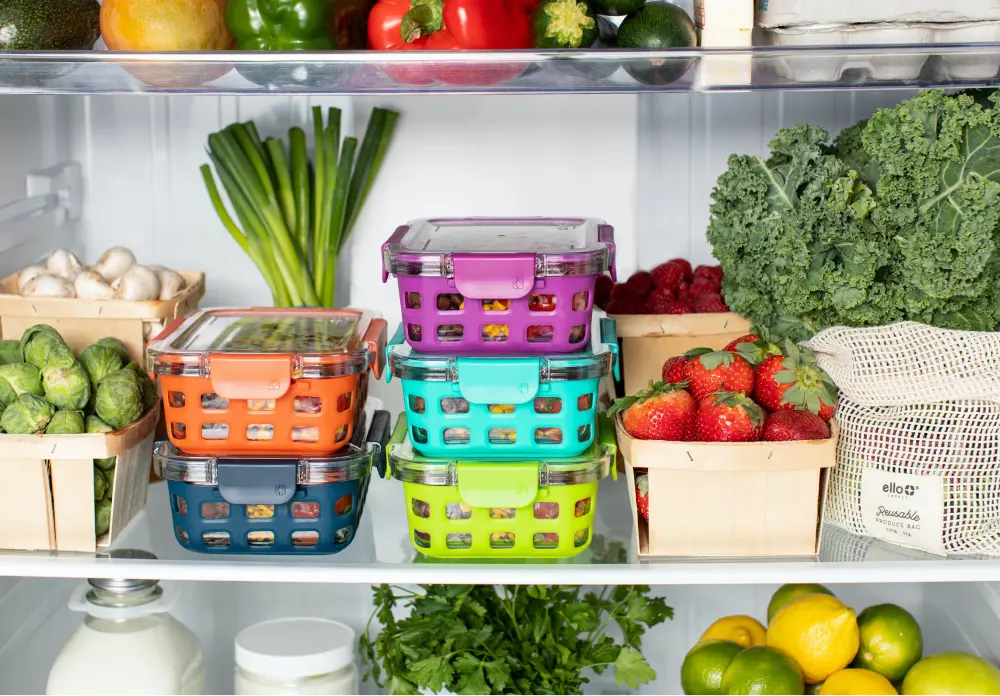Air Conditioner Upgrade Energy Savings Calculator
2 minute readHow much can you save with a more energy efficient air conditioner?
Home > BKV Energy Blog > All Posts > Energy Efficient Refrigerators Can Lower Your Electric Bill
7 minute read • Last update June 2024

Did you know that switching to an energy efficient refrigerator can help you lower your electricity bills? With energy costs on the rise and an increased emphasis on sustainable living, there’s never been a better time to consider the benefits of a new refrigerator.
Read on to discover the ins and outs of energy efficient refrigerators, how to choose the right one for you, and how to maximize your energy savings. Dive in to uncover the potential savings hidden in your kitchen.
Imagine using a fraction of the energy to power your refrigerator without compromising its performance. That’s energy efficiency in a nutshell – using less energy to do the same job. By opting for an energy efficient refrigerator, you can keep your food cool, save energy, and slash your electricity bill.
Over the past few decades, refrigerator efficiency has dramatically improved, with modern models consuming up to 73% less energy than those from the 1970s.
Innovations like improved insulation, advanced compressors, and more efficient refrigerants have played pivotal roles in reducing energy consumption. Additionally, the introduction of standards like the ENERGY STAR certification has driven manufacturers to prioritize and incorporate energy-saving technologies. As a result, modern refrigerators not only perform better but also consume a fraction of the power of their predecessors.
ENERGY STAR certification serves as a benchmark for energy-saving performance in appliances, including energy star certified refrigerators and freezers. Appliances that meet specific energy usage requirements set by the Environmental Protection Agency (EPA) are awarded the ENERGY STAR certification.
By choosing an ENERGY STAR-certified refrigerator, you’re opting for a model that is around 9 percent more energy efficient than those that meet the federal minimum energy efficiency standard. These refrigerators boast high-performance features like high-efficiency compressors, improved insulation, and temperature and defrost mechanisms, that help them run efficiently.
So, by switching to an ENERGY STAR-certified refrigerator, you could save a whopping $220 over the 12-year lifetime of the product and reduce your energy consumption by 33%.

In 2023, there will be no shortage of top-performing energy efficient refrigerators available. From top-freezer to bottom-freezer and side-by-side models, there’s a refrigerator to suit everyone’s needs and preferences.
Let’s explore some of the top energy efficient models in 2023.
When it comes to top-freezer models, there are a few that truly shine in terms of energy efficiency and performance. Here are the standout models:
LG LTCS24223S: This model from LG not only boasts superior efficiency but also features adjustable shelves and precise temperature controls to ensure your food stays fresh while minimizing energy usage.
Whirlpool WRT518SZFM: Whirlpool’s offering in this category comes with all the bells and whistles you’d expect from a top-tier refrigerator. Its energy-saving capabilities are complemented by its versatile shelving options and advanced temperature management system.
Frigidaire FFTR1821TS: Frigidaire’s model is a testament to the brand’s commitment to energy efficiency. With its adjustable shelves and state-of-the-art temperature controls, it’s a perfect fit for any kitchen looking to save on energy bills.
Each of these models is equipped with a suite of features that make them a prime choice for modern kitchens.
When it comes to bottom freezer models in 2023, there are certain models that stand out for their energy efficiency and user-friendly design. Here’s a closer look at the best in the market:
LG LFXS30796D: LG’s offering in this category is not just about energy efficiency. Its design ensures that frequently used items are easily accessible, making your kitchen experience seamless and eco-conscious.
Samsung RB10FSR4ESR: Samsung’s model combines innovative technology with energy-saving features. The bottom-freezer design ensures that your most-used items are always within reach, making it a practical choice for the modern kitchen.
Whirlpool WRF535SWHZ: Whirlpool continues to impress with this model, which prioritizes energy efficiency without compromising on design. The bottom-freezer layout is perfect for those who want easy access to their favorite items without the hassle.
The bottom-freezer design of these models is not just a style statement. It’s a thoughtful feature that ensures you can quickly grab what you need, reducing the time the fridge door is open and, consequently, saving energy.
In the realm of side-by-side refrigerators, there are a few models that boast of a blend of energy efficiency and innovative design. Here are the cream of the crop:
LG LFXS30796D: This LG model is not just about energy conservation. It boasts unique features that set it apart from the rest, ensuring that your food stays fresh while optimizing energy use.
Samsung RF28K9070SR: Samsung’s entry in this category combines spacious storage with adjustable shelving, allowing you to customize your fridge space while benefiting from its energy-saving capabilities.
Whirlpool WRX735SDHZ: Whirlpool’s model is a testament to the brand’s commitment to both organization and energy efficiency. With ample storage space and adjustable shelves, it’s a top choice for those keen on an organized and eco-friendly kitchen.
Investing in one of these side-by-side refrigerators ensures not only a reduction in your energy bills but also a kitchen that’s both functional and stylish.
When selecting a refrigerator, it’s essential to consider the size and capacity that will fit your space and usage requirements. The rule of thumb for size and capacity is usually 4 to 6 cubic feet of refrigerator space per person.
Make sure to measure the area where you plan to place your refrigerator before you buy. Don’t forget to confirm that there is enough space for ventilation.

The EnergyGuide label is a valuable tool for understanding the energy efficiency of a refrigerator, comparing different models, and estimating annual energy costs.
This label, required by law to be displayed on all new appliances sold in the United States, provides crucial information about the energy consumption of different models and can help you make a well-informed decision when purchasing a new refrigerator.
By taking the time to read the EnergyGuide label, you can make an informed decision about which product to choose.
The EnergyGuide label, often accompanied by the energy star label, includes essential information such as the annual energy cost or efficiency info, a comparison of energy usage with similar models, the model number and size, key features of the appliance, and the brand and capacity information.
Here’s how to read it:
Estimated Annual Operating Cost: This section gives you a quick glance at what the refrigerator might cost you annually to operate, based on the national average electricity rate and typical usage.
Energy Consumption in kWh: This number tells you how much energy the refrigerator uses in a year. Lower kWh figures indicate a more energy-efficient model.
Comparison Scale: The label often includes a scale showing how the model’s energy usage compares to the energy consumption of other similar models. This can help you see where the refrigerator stands in terms of efficiency among its peers.
ENERGY STAR Logo: If the refrigerator is ENERGY STAR certified, the label will feature this logo, signifying that the model meets specific efficiency guidelines set by the U.S. Environmental Protection Agency.
Key Features: The label may also list key features of the appliance, such as its capacity, brand, and model number. This information helps you compare similar models.
QR Code: Some EnergyGuide labels include a QR code that you can scan with a smartphone to get more detailed information online.
Consideration of Usage: Remember, the figures provided are based on standard usage. Your actual costs and energy consumption may vary depending on how you use the appliance.
By carefully reading and understanding the EnergyGuide label on a refrigerator, you can make an informed decision that aligns with both your energy-saving goals and functional needs.
The EnergyGuide label provides an accessible way of contrasting the energy usage of numerous refrigerator models. Comparing these models becomes effortless with such a convenient tool. It shows the projected average electricity cost for each model based on typical usage, helping you make an informed decision when looking at various models.
To estimate the annual energy costs of a refrigerator using the EnergyGuide label, simply look at the projected average electricity cost shown in a range for similar refrigerators.
For instance, if the label states that the refrigerator uses 500 kWh of energy annually and the national average cost of energy is $0.12 per kWh, the estimated annual energy cost for that refrigerator would be 500 kWh x $0.12 = $60.
Learn How kWh (killowatt-hours) are calculated.

Once you’ve selected the perfect energy efficient refrigerator for your home, it’s time to maximize your energy savings. Proper installation, regular maintenance, and adopting efficient usage habits can help you get the most out of your new refrigerator and further reduce your energy usage.
The first step to saving money with your new refrigerator is proper installation and placement.
Set the temperature between 35 to 38 degrees Fahrenheit, ensure the refrigerator is properly leveled, and arrange items inside to avoid blocking vents.
Additionally, keep your refrigerator away from direct sunlight and other sources of heat like ovens or ranges to maintain optimal performance.
Regular maintenance and cleaning are crucial for ensuring energy-saving performance in your refrigerator.
Clean the inside and outside of your refrigerator regularly, check the door seals for any damage, and make sure the temperature settings are accurate.
By keeping your refrigerator in good shape, you can maintain its efficiency and prolong its lifespan.
Adopting efficient usage habits can further reduce the energy consumption of your refrigerator. Keep the door closed as much as possible to reduce air leakage, and avoid overfilling the refrigerator, as this can obstruct airflow and make the refrigerator work harder to maintain the desired temperature.
In addition to these habits, use your refrigerator’s energy-saving mode if available, and replace the water and air filters regularly to maintain optimal performance.
When it comes to disposing of your old refrigerator, energy efficient models offer responsible disposal and recycling options. Retailers that partner with the EPA’s Responsible Appliance Disposal (RAD) program will pick up your old refrigerated appliances and recycle the materials, including the metal cabinet, plastic liner, and glass.
Additionally, local utility companies or energy providers may offer appliance recycling programs with incentives like rebates.
While energy-efficient refrigerators are a fantastic way to boost your savings and promote sustainable living, choosing the right energy provider can amplify these benefits.
With BKV Energy, you’re not just choosing an energy provider; you’re choosing a partner committed to a greener, more sustainable future. So, as you consider upgrading to an energy efficient refrigerator, remember that BKV Energy is here to support you every step of the way.
Graham Lumley, Digital Marketing Manager at BKV Energy, leads digital and traditional marketing strategies, focusing on educating Texans about the state's deregulated energy market. With over 8 years of marketing experience, he creates content to help consumers understand and save on their energy bills, bringing a fresh and dynamic approach to the industry.

How much can you save with a more energy efficient air conditioner?

Is it worth to pay the Early Termination Fee to switch electricity plans?
Get $50 off your electric bill!
Use code BKVEJOINUS50
Enter your zip code to shop BKV Energy's affordable, fixed-rate Texas electricity plans. Use the promo code for $50 off your electric bill.